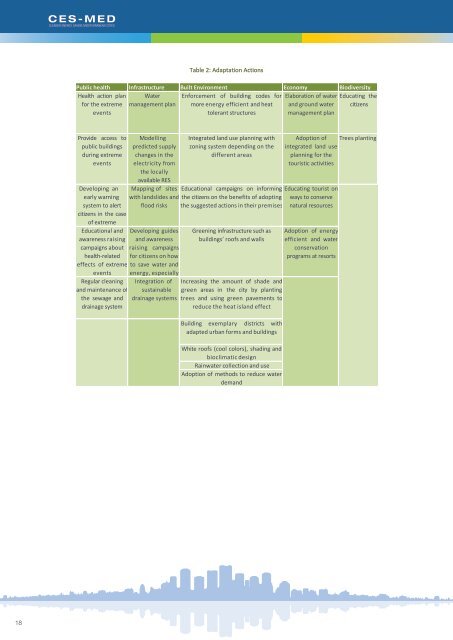161117_Jordan_ASEZA_SECAP_Revised
Create successful ePaper yourself
Turn your PDF publications into a flip-book with our unique Google optimized e-Paper software.
Table 2: Adaptation Actions<br />
Public health Infrastructure Built Environment Economy Biodiversity<br />
Health action plan Water Enforcement of building codes for Elaboration of water Educating the<br />
for the extreme<br />
events<br />
management plan more energy efficient and heat<br />
tolerant structures<br />
and ground water<br />
management plan<br />
citizens<br />
Provide access to<br />
public buildings<br />
during extreme<br />
events<br />
Developing an<br />
early warning<br />
system to alert<br />
citizens in the case<br />
of extreme<br />
Educational and<br />
awareness raising<br />
campaigns about<br />
health-related<br />
effects of extreme<br />
events<br />
Regular cleaning<br />
and maintenance of<br />
the sewage and<br />
drainage system<br />
Modelling<br />
predicted supply<br />
changes in the<br />
electricity from<br />
the locally<br />
available RES<br />
Mapping of sites<br />
with landslides and<br />
flood risks<br />
Developing guides<br />
and awareness<br />
raising campaigns<br />
for citizens on how<br />
to save water and<br />
energy, especially<br />
Integration of<br />
sustainable<br />
drainage systems<br />
Integrated land use planning with<br />
zoning system depending on the<br />
different areas<br />
Educational campaigns on informing<br />
the citizens on the benefits of adopting<br />
the suggested actions in their premises<br />
Greening infrastructure such as<br />
buildings’ roofs and walls<br />
Increasing the amount of shade and<br />
green areas in the city by planting<br />
trees and using green pavements to<br />
reduce the heat island effect<br />
Building exemplary districts with<br />
adapted urban forms and buildings<br />
White roofs (cool colors), shading and<br />
bioclimatic design<br />
Rainwater collection and use<br />
Adoption of methods to reduce water<br />
demand<br />
Adoption of Trees planting<br />
integrated land use<br />
planning for the<br />
touristic activities<br />
Educating tourist on<br />
ways to conserve<br />
natural resources<br />
Adoption of energy<br />
efficient and water<br />
conservation<br />
programs at resorts<br />
18

















